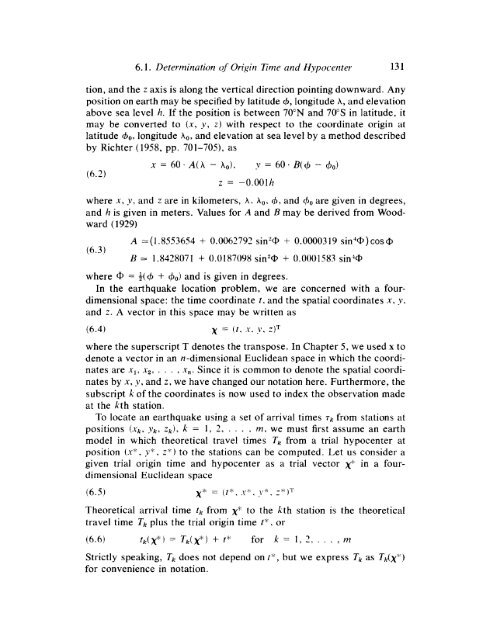principles and applications of microearthquake networks
principles and applications of microearthquake networks
principles and applications of microearthquake networks
You also want an ePaper? Increase the reach of your titles
YUMPU automatically turns print PDFs into web optimized ePapers that Google loves.
6.1. Determination <strong>of</strong> Origin Time <strong>and</strong> Hypocenter 13 1<br />
tion, <strong>and</strong> the z axis is along the vertical direction pointing downward. Any<br />
position on earth may be specified by latitude 6, longitude A, <strong>and</strong> elevation<br />
above sea level h. If the position is between 70"N <strong>and</strong> 70"s in latitude, it<br />
may be converted to (x, y, z) with respect to the coordinate origin at<br />
latitude bo, longitude A,, <strong>and</strong> elevation at sea level by a method described<br />
by Richter (1958, pp. 701-703, as<br />
(6.2)<br />
x = 60*A(h - A,), y = 60-B($ - 40)<br />
i = -0.001h<br />
where x, y, <strong>and</strong> z are in kilometers, A. A,, 4, <strong>and</strong> 4, are given in degrees,<br />
<strong>and</strong> h is given in meters. Values for A <strong>and</strong> B may be derived from Woodward<br />
(1929)<br />
(6.3)<br />
A ~(1.8553654<br />
+ 0.0062792 sin2@ + 0.0000319 sin4@)cos@<br />
B = 1.8428071 + 0.0187098 sin2@ + 0.0001583 sin4@<br />
where @ = $(+ + 4,) <strong>and</strong> is given in degrees.<br />
In the earthquake location problem, we are concerned with a fourdimensional<br />
space: the time coordinate t, <strong>and</strong> the spatial coordinates x, y,<br />
<strong>and</strong> z. A vector in this space may be written as<br />
(6.4)<br />
x = (t, .Y, y. z)T<br />
where the superscript T denotes the transpose. In Chapter 5, we used x to<br />
denote a vector in an n-dimensional Euclidean space in which the coordinates<br />
are x,. x2, . . . , x,. Since it is common to denote the spatial coordinates<br />
by x, y, <strong>and</strong> i, we have changed our notation here. Furthermore, the<br />
subscript k <strong>of</strong> the coordinates is now used to index the observation made<br />
at the kth station.<br />
To locate an earthquake using a set <strong>of</strong> arrival times 7k from stations at<br />
positions (xk, yk, zk), k = 1, 19 7 . . . . rn. we must first assume an earth<br />
model in which theoretical travel times Tk from a trial hypocenter at<br />
position (x", y* , z* 1 to the stations can be computed. Let us consider a<br />
given trial origin time <strong>and</strong> hypocenter as a trial vector x* in a fourdimensional<br />
Euclidean space<br />
(6.5) x* = (I*. .v*. ),* .-*)'I.<br />
Theoretical arrival time fk from x* to the kth station is the theoretical<br />
travel time Tk plus the trial origin time t", or<br />
(6.6) tk(X*) = Tk(x*) + t*<br />
Strictly speaking, Tk does not depend on t", but we express Tk as ak(x")<br />
for convenience in notation.<br />
for<br />
k = 1, 2. . . . , rn






